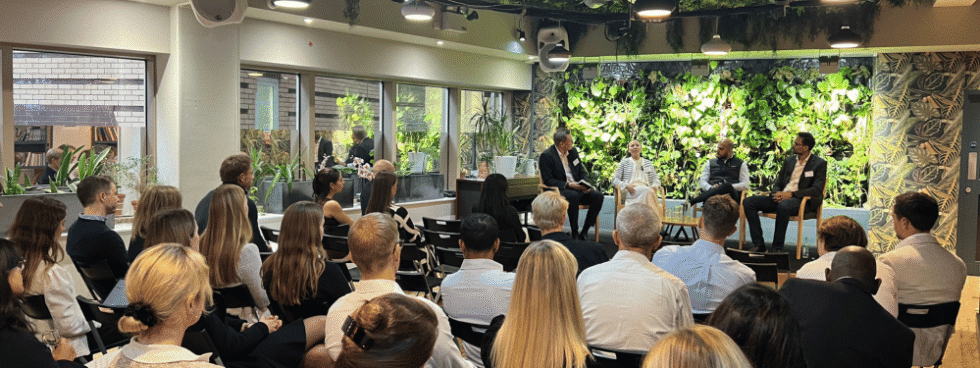
How to
Meeting LP Expectations: How to Deliver a Modern Investor Experience in 2026
Written by Christopher Vilhelmsen and Teodora Aleksieva
Recent shifts in the fundraising market have made delivering a seamless investor experience a strategic differentiator. Firms that modernize their systems and processes are building stronger relationships and gaining an edge in future fundraising.
In a recent panel discussion, leaders from Apax, Generation Investment Management, Holland Mountain and Atominvest explored the latest trends shaping LP experience, what LPs will be expecting, where friction remains, and how technology and change management can close the gap.
Summary:
- LP expectations have evolved significantly. They want more than quarterly PDFs, but not an overload of data. LPs are looking for insights that genuinely add value.
- Fragmented platforms create friction and operational bottlenecks. A unified, investor-centric digital infrastructure is essential for removing barriers and enhancing the overall experience.
- GPs are actively investing in technology to bridge the gap between expectations. From onboarding solutions that provide a guided journey for LPs to modern investor portals that simplify access and offer dynamic performance dashboards.
- AI is shifting from hype to practical value, improving efficiency in how firms interact with investors and create deeper connections.
- A successful investor experience program starts with a shared vision focused on the experiences for LPs - not just the systems. Firms need a long-term plan that connects strategic goals with evolving investor expectations.
- As GPs attract different types of LPs, such as those from wealth and retail channels, automated processes like digital onboarding are becoming critical to scaling investor volumes without increasing internal headcount.

What is Investor Experience?
Investor experience is the overall quality of a Limited Partner’s interactions with a fund manager, shaped by how intuitively, transparently, and efficiently information, processes, and relationships are managed across the entire investment lifecycle.
How are LP expectations changing?
What investors now expect
LP expectations have evolved significantly. They are looking for more than the quarterly PDF; however, they are not looking for reams of data either. LPs want data that adds value.
Panelists noted how expectations are shifting:
- Because they are being inundated with all the data from all their GPs, LPs request data that is more relevant to them; however, this is on a case-by-case basis, and GPs must work with their LPs to understand their needs.
- LPs want more up-to-date and dynamic information on portfolio activity and performance.
- At the same time, LPs tend to ask more open-ended questions regarding the portfolio and increasingly request bespoke reporting templates, which is something IR teams need to be able to manage, potentially by outlining why these requests may not be ideal for the LP’s needs.
The challenge for GPs is to make information more relevant, streamlined, and easy to digest, helping investors find meaning rather than manage noise. It should also be possible to find and share this information easily.
Friction still defines too much of the investor journey
The panel highlighted persistent friction across the investor journey. Despite digital progress within the industry, processes remain fragmented and manual.
- Too many separate platforms create a disjointed experience and operational bottleneck, requiring LPs to log into multiple interfaces.
- LPs have to wait days for simple questions about the fund/assets and portfolio.
- Email-based onboarding: Often involves long back-and-forth threads, repeated document requests, and legal terms painfully negotiated over thousands of emails.
- Query management: Typically handled through mixed internal and external inboxes, with little consistency in responses across the business.
The result is inefficiency and frustration, highlighting how far private markets still have to go in delivering a unified and intuitive investor experience.
Tech and data are closing the gap
The new normal for onboarding and e-subscription documents
Panelists agreed that digital onboarding has become the new norm. Traditional processes remain slow, manual, and paper-based, often involving lengthy subscription documents and endless email exchanges.
The shift now is towards a fully automated workflow, where investors:
- Only see the fields relevant to them
- Re-use previously entered information for less data entry
- Have instant feedback on uploaded documents with AI tools
- Can complete and sign documents digitally
- Ask specific questions on legal docs that are answered quickly within the platform, reducing the investor onboarding times by orders of magnitude.
This guided approach reduces errors, shortens turnaround times, and sets a new standard for investor onboarding in private markets.
Digitizing the whole LP journey
Beyond onboarding, the discussion turned to how technology is reshaping the whole LP experience.
From how firms identify and communicate with investors to how they maintain relationships over time, there is a clear drive among GPs to align with the expectations set by other financial services, such as fintech apps and neobanks.
- Technology can make ongoing communication more personalized and efficient.
- Modern investor portals simplify access and navigation, while offering enhanced and dynamic performance dashboards. Portals also enable investors to update contact details, wire instructions, and subscribe to funds, and refresh KYC/AML/tax documents with integrated investor lifecycle management tools.
- Tech spend on investor portals can be justified by making IR teams more scalable - it shouldn’t be necessary for IR teams to hire just to support reporting for a new mandate.
Real progress depends on turning technology from an obligation into an advantage, building a unified, digital infrastructure designed around the investor experience.
The objective is to create a unified interface that delivers a seamless, end-to-end investor experience, from fundraising and onboarding through to ongoing reporting.
Having a 360-degree view of investors
On the GP side, there is a major opportunity to leverage the investor intelligence collected across every LP touchpoint to effectively engage with them.
- Investor-facing tools such as investor portals and onboarding should connect directly with the CRM to track engagement and manage access permissions.
- Integrating third-party market intelligence helps GPs understand each LP’s evolving strategy and wider commitment activity.
- Using a single source of truth or a central data platform allows GPs to aggregate and map all interactions with LPs, for example, meetings held, marketing materials viewed, data rooms accessed, queries sent, and funds committed, meaning that only systems with the requisite API capabilities should be considered.
Leveraging this deep understanding of LPs’ exposure and returns helps personalize interactions and make the whole experience better.
Will AI be a key enabler of new experiences?
One of the key questions was how AI is shifting from hype to practical value, improving efficiency in how firms interact with investors and create deeper connections.
- AI tools can support GPs at many stages, from automatically extracting data from unstructured documents, surfacing insights on investor behavior and engagement, while checking the validity of investor documents
- Enable GPs to modernize portfolio monitoring, improve reporting accuracy, and focus teams on driving insights and value, instead of wrestling with data.
- Personalized information delivery is gradually replacing one-size-fits-all reporting.
- Giving investors access to natural language querying via chatbots in data rooms and portals.
- The long-term vision is tailored investor portals that anticipate individual needs.
AI’s evolution, panelists noted, could make investor experience as personalized as a streaming platform, relevant, responsive, and on demand.
Business Change and ROI
How to best manage the change?
The panel agreed that transformation is just as much about people as it is about technology. Success starts with a shared vision focused on investor experiences, not just the systems.
- Allocating time to recognize each team’s needs, pain points, and aligning them around a clear goal is essential.
- Empower individuals to own their part of the process and act as change agents.
- Recognize that most people already have demanding day-to-day roles, which makes dedicated time for transformation difficult.
- Secure senior sponsorship and external partners to help maintain focus and momentum and ensure a single vision across all teams.
As one panelist put it, “There’s no such thing as overcommunicating,” highlighting the importance of consistent communication to keep teams engaged and aligned.
At the same time, when people see how the changes improve their daily work, it motivates them, and they take ownership; as a result, the transformation becomes sustainable.
How can you assess the impact and know you’re on the right track?
“If you don’t hear any complaints from your LPs, it means it’s working,” one panelist remarked, summing up what success in investor experience often looks like.
Measuring the success of change requires both quantitative and qualitative indicators.
On the quantitative side, firms can track metrics such as onboarding times, document downloads, logins, clicks, and overall investor engagement. Qualitative feedback comes from investor sentiment and the tone of day-to-day queries.
Some firms use NPS surveys, but the panel agreed that the clearest signals are often simpler.
- Fewer complaints usually indicate that systems are working effectively.
- Repeat commitments and referrals are the strongest proof of satisfaction.
The ultimate test is whether investors feel treated as genuine partners rather than compliance obligations.
Meeting the expectations of Private Wealth investors
New expectations
With the growing opportunity to attract capital from wealth channels and retail investors, the panel noted that these groups bring very different expectations from traditional LPs.
Having come from public markets, they are accustomed to platforms offering real-time visibility and easy access to data. Private markets, by contrast, still provide periodic reporting.
- Demand is growing for faster, more transparent, interactive experiences.
- Investors increasingly want to see where their money is invested, even without daily pricing, which creates barriers to fully assessing risk and suitability.
- Firms are exploring ways to make the experience less opaque and more engaging.
This shift toward transparency is expected to reshape how private wealth investors are served across the industry.
How is tech helping this?
This investor group expects a digital experience that matches modern banking and fintech standards, intuitive, transparent, and available on demand.
- Automated processes, such as digital onboarding, are becoming essential for handling higher investor volumes without increasing internal headcount.
- Firms must treat private wealth investors as true clients, not compliance obligations.
- Digital workflows streamline investor onboarding, subscriptions and investor lifecycle and enable teams to manage all investor interactions through centralized hubs.
Technology, the panel agreed, will be critical both to meeting these expectations and to serving this market efficiently at scale.
Last piece of advice
1. Align vision and execution. Have a long-term plan that connects the firm’s strategic goals with investor expectations. Technology and data should be built into this vision, not added as standalone projects, but as part of driving commercial outcomes.
2. Map the investor journey. Visualize every step of how investors interact with the firm. This reveals friction points and areas for improvement. Start with one problem, whether onboarding or reporting, and fix it before moving to the next.
3. Start small, one area at a time. Avoid tackling everything at once. Focus on one area that can deliver clear value, and approach it as a product, not a process. The future of investor experience will be shaped by incremental, product-led improvements.
About Holland Mountain
Holland Mountain is a specialist consultancy and data solutions provider exclusively focused on Private Markets, helping firms scale efficiently and use technology and data to gain a competitive advantage.
Our investor experience services help private capital firms modernize investor relations and create a seamless digital experience for LPs.
About Atominvest
Atominvest is a leading technology provider specializing in asset management solutions, offering a unified software platform that streamlines investor relations, AI-powered portfolio management, and compliance workflows for asset managers. With over 100K users globally and more than $5 trillion in AUM supported, Atominvest powers digital transformation across private equity, private credit, venture capital, real assets, and asset management firms.




























